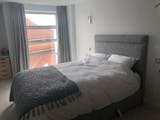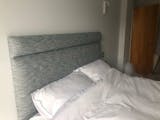Choosing the right bed for your bedroom is a significant decision, and one of the choices you'll encounter is whether to opt for a fabric bed. Fabric beds have gained popularity in recent years for their elegant and cosy appearance. However, are they a good choice for your bedroom? In this blog, we'll explore the pros and cons of fabric beds to help you make an informed decision.
Pros of Fabric Beds
Aesthetically Pleasing
One of the most prominent advantages of fabric beds is their aesthetic appeal. They bring a touch of elegance and sophistication to your bedroom. The soft and luxurious texture of fabric upholstery adds warmth and comfort, making your bed a focal point in your room's décor. Fabric beds come in a wide range of colours and patterns, allowing you to match your bed with your room's design.
Comfortable
Fabric beds are known for their comfortable and cushioned headboards. Whether you like to read, watch TV, or simply relax in bed, the padded headboard provides a comfortable and supportive surface to lean against. It's a great addition for those who enjoy spending time in bed for activities other than sleeping.
Quiet
Unlike some metal or wooden bed frames, fabric beds are generally quiet. They don't creak or make noise when you move in bed, which can be a significant benefit if you're a light sleeper or share your bed with a partner who tosses and turns during the night.
Warm and Cosy
The fabric upholstery on a bed can create a warm and cosy ambiance in your bedroom. This is especially beneficial in colder climates or during the winter months when you want your bed to feel like a welcoming haven.
Customisable
Fabric beds offer customization options. You can choose the type of fabric, colour, and pattern that best suits your style. Some manufacturers even offer tailored or bespoke options, allowing you to create a unique piece of furniture that perfectly fits your preferences.
Easy Maintenance
Cleaning fabric beds is generally straightforward. Most fabrics can be spot-cleaned or vacuumed to remove dust and debris. Some fabric beds come with removable and washable covers, making maintenance even easier.

Cons of Fabric Beds
Prone to Stains
One of the main drawbacks of fabric beds is their susceptibility to stains. Accidental spills, pet hair, and even natural body oils can leave marks on the fabric. While many fabric beds come with stain-resistant treatments, it's essential to be cautious to avoid permanent stains.
Durability
Compared to wood or metal beds, fabric beds may not be as durable. The fabric can wear over time, especially if it's exposed to direct sunlight or heavy use. This can lead to fading and a worn appearance, making the bed lose some of its aesthetic appeal.
Allergen Accumulation
The fabric upholstery on your bed can accumulate dust, allergens, and pet dander, which may not be suitable for individuals with allergies. Regular cleaning and maintenance are necessary to keep the bed allergen-free.
Price Range
High-quality fabric beds can be quite expensive. While you can find budget-friendly options, they may not offer the same level of durability and comfort as pricier models. You'll need to strike a balance between your budget and your preferences.
Limited Style Options
While fabric beds are available in various styles, they may not offer the same range of designs as metal or wooden beds. If you're looking for a specific style that isn't commonly found in fabric upholstery, you may have limited options.
Assembly and Disassembly
Fabric beds often require more care during assembly and disassembly. The fabric can easily snag or tear if not handled carefully, making moving the bed a potentially delicate process.
Long-Term Maintenance
Keeping a fabric bed in top condition requires more long-term maintenance compared to other bed materials. Regular cleaning, vacuuming, and occasional professional cleaning may be necessary to preserve the fabric's appearance and integrity.

In Conclusion
The decision of whether fabric beds are a good choice depends on your personal preferences, lifestyle, and budget. Fabric beds offer undeniable advantages, including their aesthetically pleasing appearance, comfort, and customization options. However, they come with their share of challenges, such as susceptibility to stains and allergen accumulation.
When considering a fabric bed, weigh the pros and cons carefully and choose one that aligns with your needs. To maximize the lifespan and appeal of your fabric bed, invest in a high-quality, stain-resistant fabric and commit to regular maintenance. Ultimately, the choice between fabric beds and other materials like wood or metal depends on your style, comfort, and maintenance preferences.







